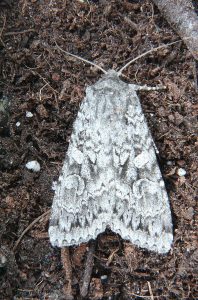2025 January 13
2025 January 13
No Invertebrate Alert was posted on January 12.
Jeremy Tatum writes: A few days ago (see January 7) I got a surprise by finding a nice noctuid moth – a Girdler Moth Dargida procincta. Libby Avis writes that: “Powell and Opler say the adults fly most of the year in the US, except for December and most of January, so that one may be less surprising given the mild winter.” Yesterday, continues Jeremy, I got another surprise of an unexpected winter noctuid. The handsome moth shown below emerged from a pupa that I had reared from caterpillar last year. Thanks to Libby for identifying it as a Great Brocade Eurois occulta. This is even less likely to be seen as an adult in winter than a Girdler Moth. Libby has never seen an adult before June, and Bug Guide says: “One generation per year; overwintering larvae become active in April, feeding until pupation occurs in June or July; adults emerge and lay eggs in late summer; eggs hatch in fall, and partially-grown larva overwinters.”
However, South, writing in 1907, says: It feeds in the autumn…. Usually it hibernates when small, but when kept indoors and fairly warm it can be induced to complete growth, and attain the moth state in October or later, sometimes even earlier.
So, although I didn’t knowingly “induce” it, it must have pupated early in the fall, instead of hibernating as a caterpillar as it should have done. I show the moth below. The caterpillar is shown on October 31, where I had originally mislabelled it as a Lesser Yellow Underwing Noctua comes.
 Great Brocade Eurois occulta (Lep.: Noctuidae) Jeremy Tatum
Great Brocade Eurois occulta (Lep.: Noctuidae) Jeremy Tatum
